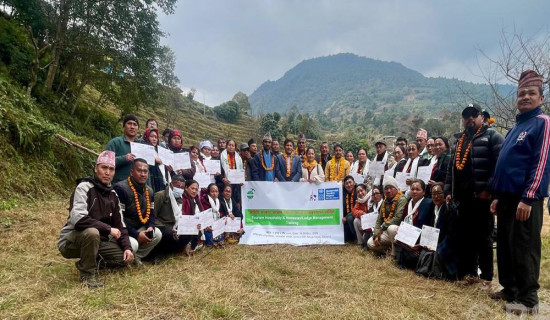- Sunday, 21 December 2025
By-elections Litmus Test For Parties’ Popularity
Major political parties are prepared to contest the by-elections, which are viewed as a litmus test for the popularity of major forces such as the CPN-UML, Nepali Congress, CPN- Maoist Centre (MC) and Rastriya Swatantra Party (RSP). The by-election will be held in Ilam constituency- 2 for a House of Representatives seat and for a provincial parliamentary seat in Bajhang (A) of Sudurpaschim Assembly on April 27. The by-election holds special significance since it occurs in the midst of a political change in the ruling alliance. Pushpa Kamal Dahal Prachanda, chairman of the Maoist Centre and Prime Minister, caused "a political upheaval" when he abandoned the Nepali Congress and formed a new ruling coalition with his former rival, the UML, and Rabi Lamichhane's RSP a few weeks ago.
Both the UML and the RSP have already announced their candidates for the by-election. The UML has chosen Suhang Nembang, the son of the late Subas Chandra Nembang, while the RSP has chosen Milan Limbu, a journalist who earlier represented the Press Centre, a media body affiliated to the Maoist Centre. Limbu, however, opted to withdraw from the MC and run as an independent candidate in the by-election instead. However, the RSP declared that it would nominate him as a candidate, and Limbu joined the party. The Nepali Congress has yet to name a candidate. The Unified Socialist Party, another significant component of the present ruling alliance, has named Jit Bahadur Rai, the former chairperson of Maijogmai Rural Municipality, to run in the Ilam by-election.
Separate candidates
The present alliance's parties chose to contest the by-elections with separate candidates. The Maoist Centre has decided to field a candidate, but there is also a possibility that it would support the UML candidate. It is notable that the ruling alliance's parties, which created the partnership in haste, have failed to endorse a consensus candidate. Rather, they are seen taking up the cudgel and selecting their candidates, implying that, despite being in the same alliance, they are not functioning as a single strong entity but are working hard to assert their superiority within it.
The UML, the largest alliance member, is the first to nominate a candidate. The party is counting on Suhang to win votes, as his father had continuously won general elections in the same constituency since 1999. The selection of young Nembang, who returned from Australia after his father’s death, is an attempt to elicit emotion from voters, which may help him win the election. However, the candidature of former journalist Limbu may pose a challenge to UML's Suhang due to the growing popularity of Lamichhane's and his party's RSP. Talks are being heard that RSP candidate Limbu is running on a promise to address the area's identity issue and the RSP's surge in popularity may help him win the by-election. Suhang and Limbu have already begun the election campaign, visiting voters' homes and appealing for their support in the election.
However, the Nepali Congress candidate should not be overlooked, as s/he has the potential to turn the election in this area on its head. It is worth noting that in the November 2022 election, the late Nembang defeated his closest rival, Dambar Bahadur Khadka of the Nepali Congress, by 1,014 votes. While the late Nembang received 30,020 votes, Khadka, a common candidate for the then-Congress-Maoist alliance, received 29,906. The results suggested that the very popular late Nembang had a tough time winning his election in the constituency dominated by members of the Limbu ethnicity, to which he also belonged.
Even though other parties and independent candidates will compete in the by-election, it will be the three parties — the UML, RSP, and Nepali Congress — that will be vying for the seat in this constituency. The Maoist Centre is likely to finish fourth if it nominates a candidate, while the Unified Socialist Party has little chance of ranking among the top three. In previous elections, politicians from parties such as the MC and the Unified Socialist won several seats in the federal and provincial parliaments, thanks to the alliance among the then-ruling coalition partners. They used to field joint or common candidates, and voters who supported the allies would vote for the common candidates.
Speculations
But in Ilam, the alliance partners are competing against one another, making this by-election more interesting, as it will be fascinating to see how central-level politicians, including party chairs, canvass and solicit votes in the Ilam constituency. How will they address ‘opposing parties that are partners in the ruling coalition' while addressing meetings in support of their own candidates? Because the three major communist parties, the UML, MC and Unified and Socialist, have decided to field candidates, it is possible that communist votes would be scattered, benefiting the candidates of the RSP or the Nepali Congress.
As the furious Congress seeks vengeance on the Maoist Centre, it will do all possible to win the Ilam constituency to expose the 'weaknesses of the alliance partners' and demonstrate that it remains popular among constituents. Some say the candidate for Congress may have a better chance of winning because there are several communist candidates contesting. Despite all of our speculations, we cannot predict how the voting pattern will unfold or how voters will express their preference for the candidate. However, it is worth noting that the by-election will serve as a litmus test for major political parties seeking to improve their performance in the next general election in 2027, which some of them refer to as Mission 84.
(Upadhyay is former managing editor of this daily.)











-(1)-original-thumb.jpg)




